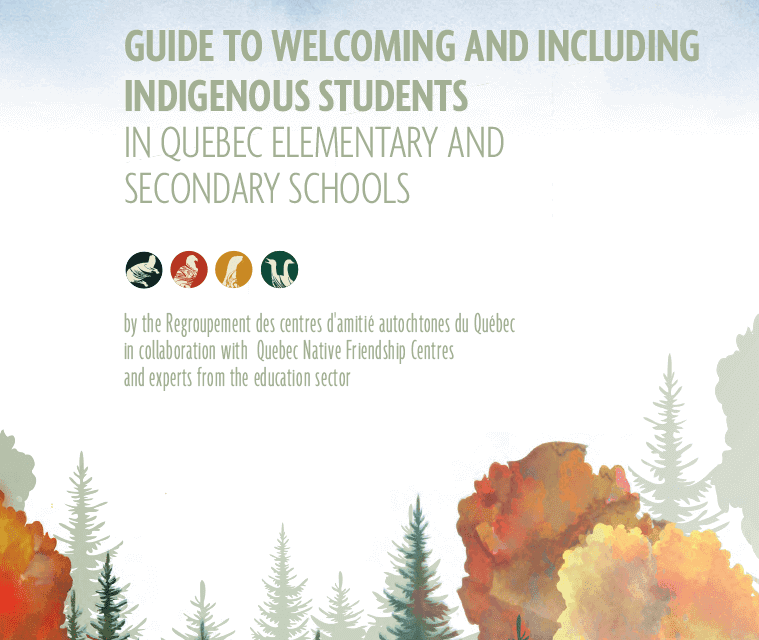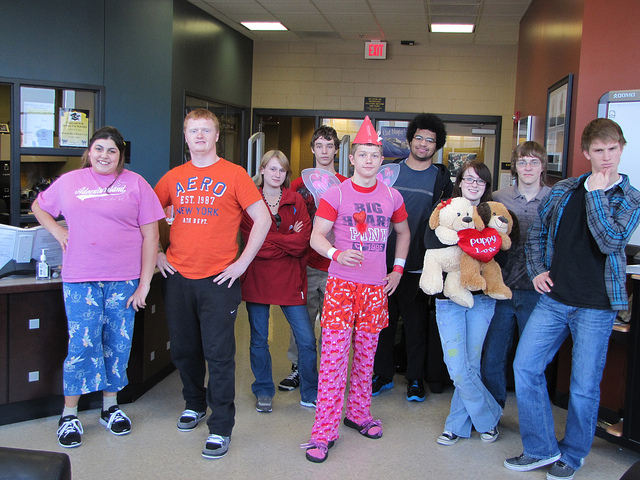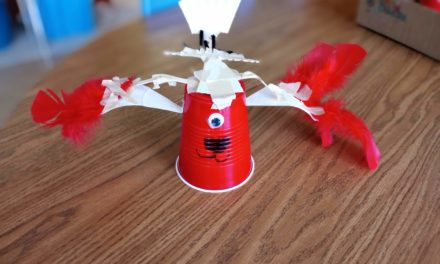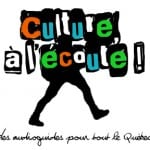LEARN recently had the opportunity to meet with Catherine Savard from the Le Regroupement des centres d’amitié autochtones du Québec (RCAAQ) to discuss the resources and supports available to Indigenous students and families in Quebec.
We also discussed the importance of schools developing a strategic plan to welcome and support Indigenous students. The RCAAQ recently collaborated with Quebec Native Friendship Centres and educators to create a “Guide to Welcoming and Including Indigenous Students in Quebec Elementary and Secondary Schools (2022)” that contains many concrete actions that schools can take to support Indigenous students (Access the French version of the document here).
All students benefit from educators nurturing Competency 15: Value and promote Indigenous knowledge, worldviews, cultures and history.
Want to learn more about the RCAAQ and how educators can work alongside Indigenous families and organizations to support the success of all students? Check out the questions and answers below.
Can you tell us about the RCAAQ (provincial association of Native Friendship Centres) and strategies or programs that support the educational success of urban Indigenous youth?
As the provincial association of Native Friendship Centres, the Regroupement des centres d’amitié autochtones du Québec (RCAAQ) has been advocating for the rights of Indigenous people in cities and supporting the work of affiliated Native Friendship Centres for over 45 years. Native Friendship Centres represent service hubs and act as cultural anchors for Indigenous people living in cities, by offering living environments and a continuum of culturally appropriate services related to a variety of sectors. Together, the Native Friendship Centres, the SIRCAAQ and the RCAAQ form the Quebec Native Friendship Centre Movement.
Education has always been recognized by the Quebec Native Friendship Centre Movement as a core priority to improve the quality of life of urban Indigenous people. Friendship Centres offer a continuum of services that provide holistic support, based on students’ and their families’ specific situations, needs and aspirations. Their educational programming promotes school retention and success while also strengthening cultural identity and empowerment in urban Indigenous people.
The Quebec Native Friendship Centre Movement has adopted an education strategy intended to intensify the development of integrated services and to promote educational success among urban Indigenous students at all levels (elementary, high school, general adult education, college and university). Indigenous cultures and languages are an integral part of all lifelong learning initiatives, and this is well reflected in the Strategy as well as in all of the Centres’ educational programming.
The RCAAQ coordinates the implementation of this strategy in its member Centres and provides them with support, by developing tools, offering training, encouraging the sharing of expertise and supporting the Centres in the planning, monitoring and evaluation of their services.
Examples of the services offered in the Native Friendship Centres:
- Tutoring and homework assistance for elementary and high school students
- Support for students in post-secondary and general adult education programs
- Support during school transitions
- Coaching and support for parents in regards to schooling issues
- Cultural programming (crafts, language courses, etc.)
- Activities to pass down traditional knowledge on the Land
- Activities that foster closer ties between peoples
The RCAAQ recently created a bilingual “Guide to Welcoming and Including Indigenous Students in Quebec Elementary and Secondary Schools (2022)”. Why was the creation of this guide important? Were there any specific catalysts?
The demand for the creation of this Guide actually came from the Native Friendship Centres themselves. Their collaboration with schools is far from always being easy and they asked for a tool that they could give to their partners in the school that would facilitate collaboration. Basic knowledge about FNI (First Nations and Inuit) and cultural competency in Quebec’s public schools varies a lot from one school to another or even from one person to another. It was important for us to offer a resource that could act as a starting point, for anyone wishing to take that first step in getting more educated about FNI realities and exploring ways to do better, to help our schools to be more inclusive and support FNI students in achieving educational success.
What I really liked about the RCAAQ guide that I found missing from other resources was the concrete actions that schools can take to welcome and support the educational success of Indigenous students. Do you have any suggestions for schools/educators who’re just getting started?
Find some allies, among your colleagues, in the school or SSC (School Service Centers), or if it’s possible in your region, reach out to a Native Friendship Centre or another community organization that supports FNI. Then, start with the actions that seem either the most necessary or the simplest to put in place. Some of the actions suggested in the Guide are huge! They imply structural changes, and institutional changes, that can’t be put in place overnight. They required a lot of thought and collaboration from a lot of different people to be put in place effectively.
Sometimes it seems easier to start small, with simple actions (like putting a map of FNI communities up in the classroom) and build on these small actions that add up, so that they help start creating, first awareness of the necessity of change, but then as these actions become more visible, more and more people inside the schools will want to improve their own practices and contribute to making the schools more inclusive.
While the RCAAQ centers are mainly located in urban areas, the welcoming guide contains actions that can be implemented to also support students in suburban and rural areas. Do you have any advice or resources to support Indigenous students and families who live in areas where they do not have access to a Friendship Center? How can educators in rural locations work alongside Indigenous families and students to ensure success?
Most of the actions suggested in the Guide can be put in place in schools and SSCs regardless of their location. Native Friendship Centres can facilitate communication with Indigenous families, but when there aren’t any Native Friendship Centres nearby, that just means it’s up to the school to create safe spaces where Indigenous families feel welcomed and heard, and make sure that they work closely with these families to determine what their needs are, and then allocate the necessary resources to ensure those needs are met.
Overall, how can schools become better allies? Can you speak a bit about the process of creating strategic plans to welcome Indigenous students? Where can schools begin and who should be included in the creation process?
Schools play such a fundamental part in Reconciliation. It’s important for schools to start by making sure all of their staff is appropriately educated and trained about FNI realities and issues. Then, schools can evaluate themselves from a structural or institutional point of view, to determine where the needs are. Then they need to allocate the necessary time and resources to make it happen (which is difficult, considering how limited school resources already are).
Creating a comprehensive strategic plan to welcome Indigenous students is not easy. It has to reflect the realities of Indigenous students and their families, which won’t be the same from one school to another. The plan should be elaborated by people in decision-making roles, in collaboration with teachers and any support staff that could be involved (social workers, special educators, etc.) as well as FNI members of staff or from community organizations, and with the input of FNI parents and students themselves.
Since the Calls of Action were published in 2015, more schools have asked to connect to Indigenous organizations. Educators sometimes ask us to connect them with Indigenous Elders, Knowledge Keepers, artists, etc. While in-person visits are ideal, I think it is important to also acknowledge the high number of requests some organizations and Elders are receiving and the importance of ensuring the requests are mutually beneficial. I believe that there is a lot of learning and unlearning that can (and should) be done using resources that were created by Indigenous Peoples before a guest speaker is even approached about a school visit. Do you have any comments about schools building relationships with Indigenous organizations and community members?
What you said is so important. Indigenous Elders, artists and even Indigenous community organizations are over-solicited. In the case of Native Friendship Centres specifically, their obligations are first and foremost to their members, to provide urban Indigenous peoples with the services they need, sometimes in emergency contexts. It’s understandable that they don’t always necessarily have the resources available to go give a cultural awareness workshop in a high school. It’s not the job of Indigenous people to educate schools. There are a lot of great resources and trainings out there for anyone willing to put in the effort.
Building relationships takes time, and schools have to be in it for the long run. They have to be committed not only to allocating the necessary resources and time, over a long period of time, but also be committed to being open and learning (and unlearning!) as the relationship evolves.
A lot of non-Indigenous educators acknowledge the importance of valuing and respecting Indigenous worldviews and cultures in their classrooms but feel hesitant about introducing content by themselves. Some are nervous that they may say or do something disrespectful. Do you have any thoughts or comments for these educators?
This is a difficult question, especially when it comes to culture. First, it’s important to always acknowledge you’re speaking as a non-Indigenous person. However, teaching about the true history of FNI peoples in Canada is extremely important, and it doesn’t require you to be of FNI heritage. It’s important to be culturally sensitive and aware, make sure not to burden or overwhelm Indigenous students. When it comes to cultural aspects, it’s trickier, but there are a lot of good resources available about how to be a good ally and find authentic Indigenous content.
Personally, I think it’s important we have the courage, as non-Indigenous people, to do the best we can to transmit this important content to all students. Will we make mistakes? Maybe. Will it mean having difficult conversations? Almost certainly. But I think if teaching is done in humility, with respect and a sincere willingness to learn and give space to authentic Indigenous perspectives, all students will appreciate the effort and everyone’s experience in the classroom will be all the better for it.
For more information, we encourage you to visit the RCAAQ website. We also encourage you to visit the LEARN Education for Truth and Reconciliation Padlets (EN / FR) if you are looking for more resources on allyship and Education for Reconciliation in Quebec. LEARN will be hosting several upcoming networking sessions and webinars. On Feb 23, 2023, from 3:00 pm – 4:00 pm, we will welcome Rebekah Goertzen, for a webinar on engaging Indigenous youth and creating culturally safe classrooms.





